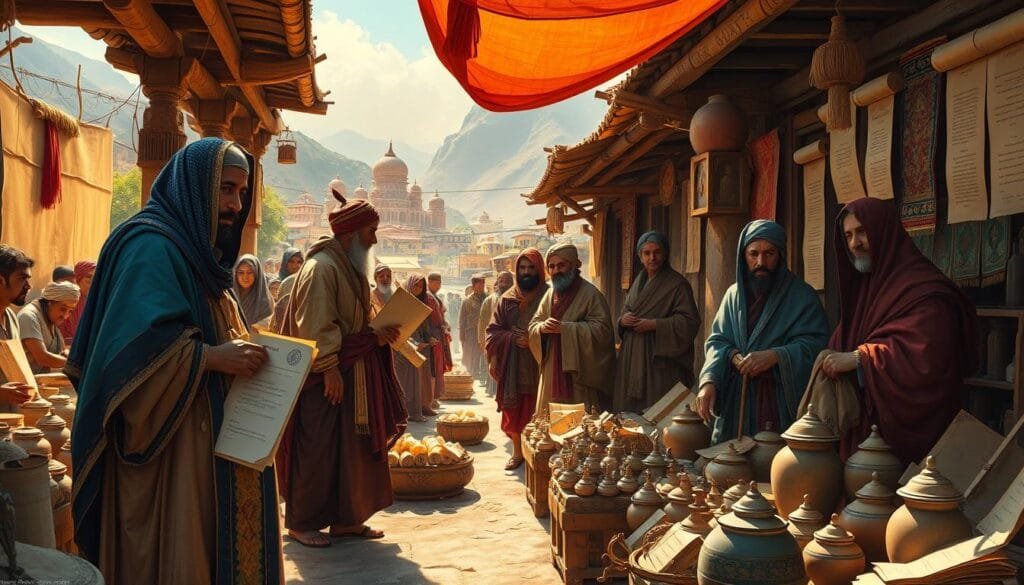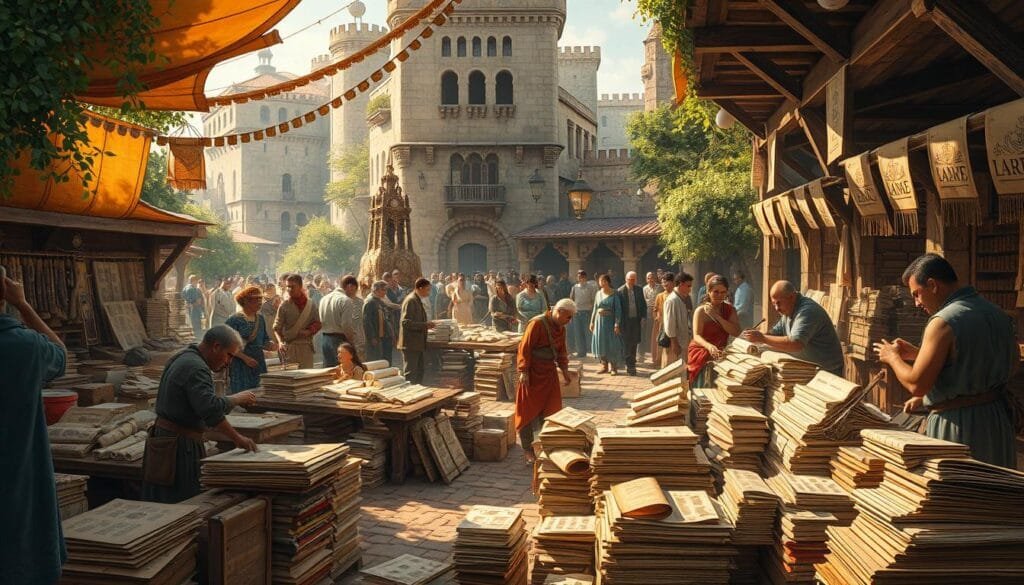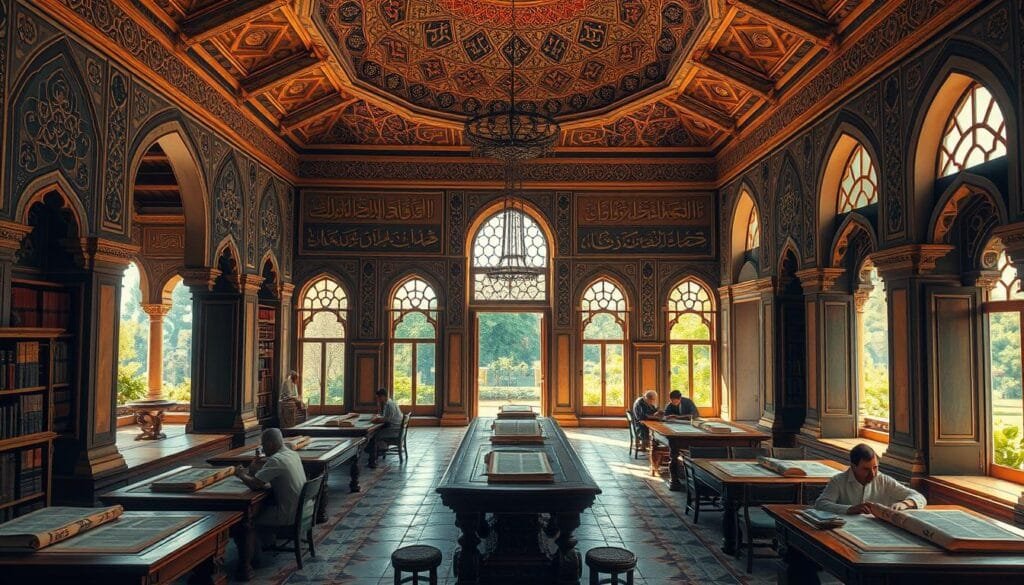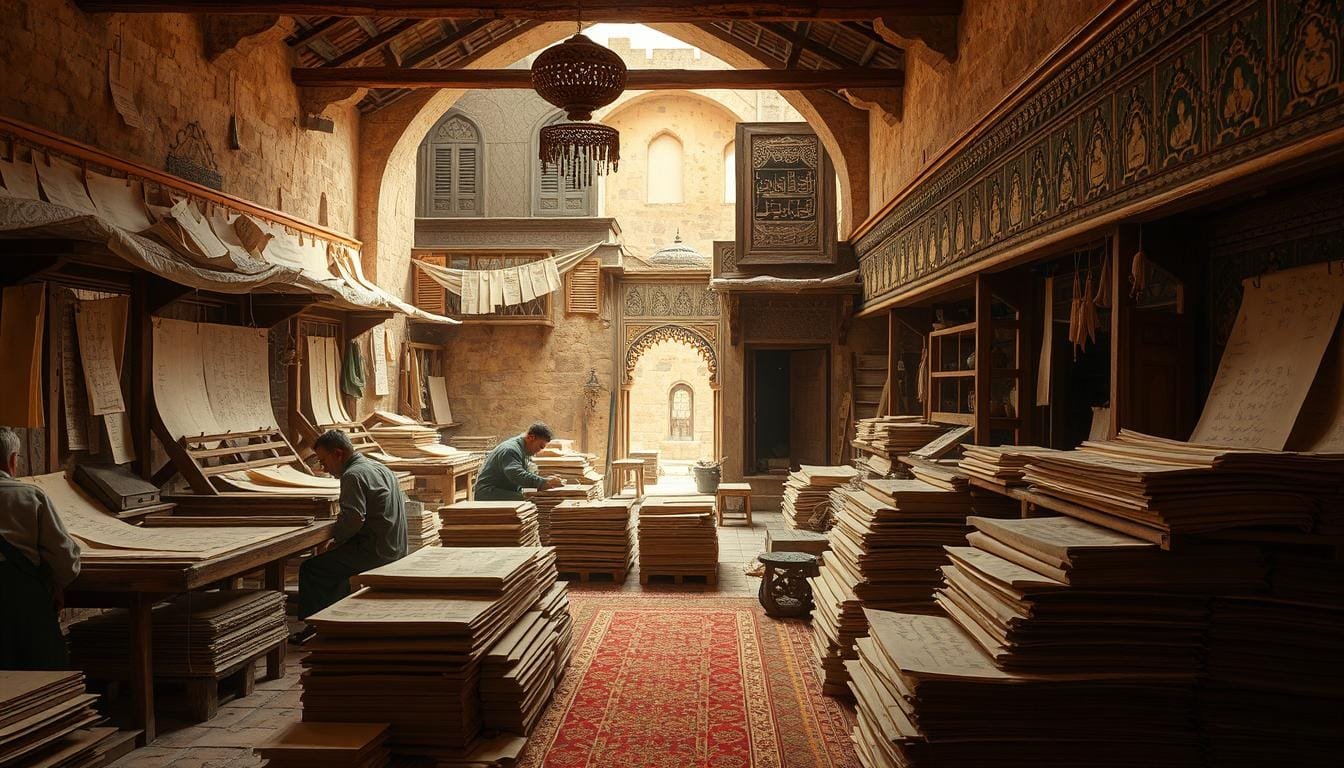Have you ever thought about how papermaking changed cultures around the world?
Paper’s journey began in ancient China and reached the Islamic Caliphates, changing Europe’s culture and how knowledge spread. This technology was mastered in China and then given new life in the Muslim world after the 8th century. Places like Baghdad became key centers for paper, with more than a hundred shops by the ninth century.
The big question is: what caused this huge change? The progress in Islamic paper production played a big role. The Silk Road helped, not just with trading goods but also ideas and technologies, connecting China, Islamic lands, and Europe.
Key Takeaways
- Introducing paper to Baghdad in the late 8th century changed how the Islamic world shared knowledge.
- Paper quickly replaced old materials like papyrus and parchment across the Arab Mediterranean.
- By the 9th century, Baghdad became a main place for trading and creating new paper products.
- The Silk Road helped spread paper and culture among different cultures.
- The advances in paper production by the caliphates helped bring about an Islamic Renaissance, pushing forward science, culture, and technology.
The Origins of Papermaking and Its Journey to the Islamic World
Understanding how papermaking started in China and its importance in the Islamic world is fascinating. It shows us the impact of paper on societies and knowledge sharing. The journey of papermaking is a story of cultural exchange and development.
Introduction to Papermaking in China
China started making paper around 200 BCE, and it changed quickly. By 105 CE, Ts’ai Lun, a Chinese official, announced the papermaking process. This was a big moment. Before, people made paper from mulberry bark, hemp, and rags. They turned it into pulp and then into thin sheets. This method was key for large-scale printing, like when Japan made one million paper pieces in 770 CE.
Islamic Conquests and the Introduction of Paper
In the 8th century, the Islamic world began using paper because of the Islamic conquests. The first water-powered paper mill in Baghdad, built in 794 CE, was important. It showed the spread of Chinese papermaking to Central Asia. During Samarkand’s golden age, paper production boomed. This made it easier to share knowledge across the Islamic Caliphate.
Supplanting Papyrus and Parchment: Advantages of Paper
Moving from papyrus and parchment to paper had many benefits. Paper was stronger and could be made anywhere, unlike papyrus. It was hard to erase written words on paper. This made documents more secure. The Abbasid Caliphate noticed this advantage. So, they quickly adopted paper. It became a big part of their record-keeping and culture.
| Year | Milestone |
|---|---|
| 200 BCE | First known instances of papermaking in China |
| 105 CE | Ts’ai Lun formally records papermaking process |
| 770 CE | First mass printing on paper in Japan |
| 794 CE | First water-powered paper mill in Baghdad |
| 1151 CE | Use of wires in paper molds begins in Xativa, Spain |
How is the Caliphate Producing Paper Cultural Transfer
The Silk Road was a vital path that connected the East with the West. It led to the trade and spread of many technologies. Among these was the technique of making paper, which traveled from China to the Islamic world. This journey of knowledge made the Islamic territories a place where paper production flourished.
Technological Diffusion via the Silk Road
Papermaking technology reached the Islamic caliphates through the Silk Road. This happened around the time of the Battle of Talas River, a key event in history. This period marked the start of papermaking techniques being adopted and adjusted to fit the needs of Islamic communities.
The Silk Road’s role in this was crucial. It brought skilled workers and materials needed for making paper right into the Islamic lands. This transformed paper from a handcrafted item to a major industry.

Adoption and Adaptation of Chinese Papermaking Techniques
The Islamic world adapted papermaking out of need and ingenuity. They took the Chinese methods and changed them to suit their own requirements. This led to the creation of paper from silk and later, cotton paper, known as “dimashqi”.
The historian Dard Hunter highlights this knowledge transfer. He shows how it benefitted the economy and culture of the region. In 794 AD, Baghdad saw the opening of its first paper factories. This was under the rule of Abbasid Caliph Harun al-Rashid.
The shift to paper reduced the reliance on papyrus and parchment. This made writing materials more affordable. It led to cheaper documents and easier access to paper for everyone.
Paper became easier to make, changing the economy and culture. During medieval times, unskilled workers in the Middle East earned well. This indicates they had more money than those in nearby regions. This wealth helped support the growing paper industry, vital for recording and learning.
Europe eventually adopted papermaking as well, though it took some time. The first paper factory in Europe opened in the 13th century in Spain. The Islamic world’s version of Chinese papermaking techniques had a wide and lasting impact. As printing technology rose, so did the need for paper.
The whole adaptation process shows a complex exchange of ideas and technology. This was crucial in shaping the history and global influence of papermaking.
The story of the Silk Road cultural exchange and technological transfer in paper production is significant. It not only reshaped the Islamic world but also left a legacy across the globe. For more details, check out Dard Hunter’s work for a deep dive into this fascinating history.
The Impact of Paper on the Islamic Renaissance
The Islamic Renaissance took place from the 8th to the 13th century. It marked a time of great cultural and scientific growth. Paper, introduced in the 10th century, had a big impact.
Transformation of Documentation and Record-Keeping
Paper made documenting easier and cheaper across the Islamic world. People moved from telling stories to writing them down. This helped in accurately sharing laws, scientific facts, and religious teachings.
The Quran, for example, could now be widely and reliably shared. Record-keeping also got better, helping in administration, law, and business.
Cultural and Scientific Advancements
Arab scholars saved many important ancient texts thanks to paper. They translated works on many subjects into Arabic. The House of Wisdom in Baghdad was a key center for this work.
There, scholars improved and added to texts on subjects like astronomy and medicine. They also made beautiful manuscripts, showing the value of knowledge and art.
Paper as a Medium for Religious and Literary Works
Paper was crucial for religious and literary works too. It helped produce a lot of written material. For example, Hunain ibn Ishaq wrote key medical texts that were widely used.
Islamic calligraphy, combining art with faith, also thrived. The Quran and other works were presented in beautiful ways. This artistic effort was a big part of the Islamic Renaissance.
Economic and Commercial Growth in the Paper Economy
In the medieval times, the Islamic world experienced a huge growth in their economy. This was mainly due to the advances in the *paper economy*. The paper industry made it easier for people to deal with money, keep records, and trade. This change brought widespread wealth.
Paper Economy and Financial Instruments
The rise of the paper economy led to the creation of new *financial instruments in the Islamic world*. For instance, the sakk, similar to today’s checks, made it easy for merchants to do business over long distances. Plus, the suftaja, a kind of IOU, meant money could be sent without moving physical coins.
Islamic banks, from the 9th to 14th centuries, played a big role. They helped out without interest, supporting commerce and giving credit to merchants. An interesting method they used was cashing checks in different cities, which began around the 9th century in places like Baghdad and Morocco.
Trade and Commerce Expansion
Paper really helped trade to grow spectacularly. The use of common currency, like the dinar, along with Arabic silver dirham coins, helped build large trade networks. These networks connected Islamic lands and even reached Europe, India, China, and Africa.

Early contracts and partnerships, such as mufawada, played a big part in kick-starting merchant capitalism. It made business easier for traders. By working together, they could share risks and boost trade activities.
Also, setting up rules and formal markets during the Islamic Golden Age helped trade a lot. Trade both locally and over long distances got better, making the Islamic world more prosperous. This wave of economic success changed the Islamic world’s finance and trade forever.
To sum up, the smart use of paper in economic and trade areas transformed the financial scene of the Islamic world. This growth and the innovative spirit left a lasting mark on global trade practices.
The Role of Knowledge and Learning in the Islamic World
In the Islamic world, seeking knowledge was more than just studying. It was a core value of the culture. The introduction of paper-making from China made learning accessible to more people. This helped Islamic knowledge grow, especially during the Golden Age from the 8th to the 14th centuries.

Places like the Bayt El Hikmah in Baghdad were key in this era. Founded in the 9th century, it had over a million books at one point. These learning hubs mixed religious and secular studies. This mix led to great strides in many fields, such as math and medicine.
Cities like Timbuktu became beacons of knowledge, drawing scholars from across Africa. Here, education sparked deep discussions on a variety of topics. The exchange of ideas along the Trans-Saharan Trade Routes showed how connected the Islamic world was.
The influence of Islamic scholarship reached beyond its borders, affecting Europe too. Works by scholars like al-Khwarizmi and Ibn al-Haytham were translated into Latin. These works became crucial in European education.
| Centuries | Centers of Learning | Contributions |
|---|---|---|
| 8th-14th | Bayt El Hikmah, Baghdad | Scientific advancements and preservation of knowledge. |
| 13th-14th | Timbuktu | House of vast libraries; attracted scholars from Africa and beyond. |
| 11th-14th | Toledo, Sicily | Major centers for translation and dissemination of Islamic texts to Europe. |
The impact of Islamic learning traditions is profound. They advanced education in the Caliphate and shaped global knowledge systems. Their legacy lives on in modern science and philosophy.
Conclusion
The story of how papermaking traveled from China to the Islamic world and then to Europe shows the power of sharing cultures and technologies. The Abbasid Caliphate, ruling between 750 to 1258 and then from 1261 to 1517, had a key role. They took Chinese papermaking skills and improved them. This led to new standards in making manuscripts that we still use today.
In the Islamic world, the use of paper changed the economy, helped scholars, and spread religious and literary works. Paper changed how people kept records and traded. This wasn’t just helpful. It sparked the Islamic Renaissance, leading to remarkable cultural and scientific discoveries.
Islamic papermaking’s impact can still be seen. It helped spread knowledge across Islamic lands and made a mark on the world. The Abbasids’ work with paper helped Europe’s medieval universities grow and brought a wider intellectual awakening. Thinking about this history, we see how important Islamic papermaking was in creating our modern world.
FAQ
What is the historical significance of Islamic papermaking?
Papermaking traveled from ancient China to the Islamic Caliphates. It changed Europe’s material culture. It also helped share knowledge and culture worldwide.
How did papermaking originate and evolve in China?
Paper was first made in China for keeping records. Over time, it improved. Then, it spread to the Islamic world, becoming a key industry.
How did the Islamic conquests influence the spread of papermaking technology?
After conquering Central Asia in the 8th century, Muslims saw paper’s benefits. They adopted and improved it. This changed the paper industry and culture.
Why was paper preferred over papyrus and parchment in the Islamic world?
Paper was easier and harder to fake than papyrus or parchment. Its superior qualities made it ideal for records. This helped its widespread use in government and society.
What role did the Silk Road play in the spread of papermaking?
The Silk Road helped share goods, knowledge, and skills between China and the Islamic world. Through this route, papermaking became a major industry in Islamic societies.
How did paper impact the Islamic Renaissance?
Paper changed how information was recorded and shared. It was key in spreading texts like the Quran. This sparked a cultural and scientific surge across the Islamic world.
What economic changes did papermaking bring to medieval Islamic society?
The paper industry boosted the economy through trade. It led to financial tools like checks. This improved trade and commerce greatly.
How did the widespread adoption of paper influence knowledge and learning in the Islamic world?
Paper made learning accessible to more people. A focus on education led to advancements in science, philosophy, and theology.
What is the legacy of Islamic papermaking in world history?
Islamic innovations in papermaking changed economies, cultures, and knowledge. This lasting impact shows the importance of Islamic papermaking in world history.
